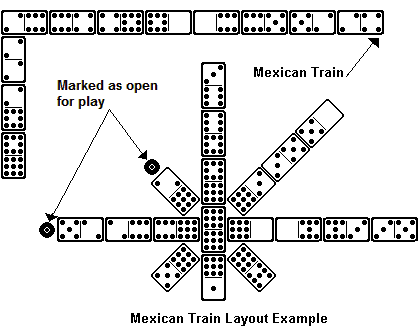|
|
|
 domino-play domino-play |
How to play... |
|
|
|
Mexican TrainA very popular block-type domino game, played by anywhere from 2 to 16 players using a Double-Nine up to a Double-Eighteen domino set, chips, coins, or counters as markers, and a score-sheet. This game can take hours to play. Play: The dominoes are shuffled, facedown, then each player draws a set number of tiles that only they can look at. The number of tiles drawn depends on the number of players taking part and the type of domino set being used and is as follows: Double-Nine:
Double-Twelve:
Double-Fifteen:
Double-Eighteen:
Any remaining tiles are used as the boneyard and may be drawn upon by players during the course of play. The first round is started by the player holding the highest double in the set, who plays (sets) it to the centre of the playing area. Should no player hold it, then players in turn continue to draw a tile from the boneyard until the double is drawn and played. Then players in turn place one of their tiles onto the open ends of the domino layout with same-number adjacent to same-number (doubles placed inline onto ends and not allowing play to branch four ways). Players may play either onto their own personal train radiating from the centre double, a separate Mexican train running around the playing area, or another player's marked open train. A player's personal train is started by playing a matching tile, onto the central set double, pointing out in its player's general direction. Players place a marker on the end of their personal train to show it is open and available for play, whenever they are unable to make a play themselves. The separate Mexican train of tiles runs around the playing area and can only be played on one end. Any player may start the separate Mexican train but the initial tile played must bear the central initially set double's suit. Should a player be unable to play a tile either onto their own train, the Mexican train, or another player's marked open train, then they must draw a tile from the boneyard or pass on their turn if the boneyard has been exhausted. If they draw a new tile, they must immediately play it, but if they are unable to, then they must mark their own train as open for play. Once a player has made a play, they remove any marker from their own personal train of tiles. Should a player play a double, they must play another tile anywhere on the layout. Players are allowed to play more than one double in a turn as long as there is a matching open end available, but are only required to play one subsequent tile. Should a player play any doubles and be unable to make another subsequent play, then they must draw from the boneyard and the previously described rule for drawing still applies. The only exception to this rule is when a player has only one remaining double as their hand, in which case they may play it to go out.
Once a player is down to one tile in their hand, they must announce it, which is usually done by tapping the domino on the playing surface. Once a player has dominoed by playing all the tiles in their hand, each of the other player's tiles' pip values are totalled and scored accordingly. Subsequent rounds are played, as before, with each round starting with the next highest double in the set until all the doubles have been used as the initial starting tile. Once all the doubles down to double-blank have been played in a round, the players' scores are totalled and the lowest scoring player, wins the game. Variations: Players are only allowed to remove their marker when they are able to make a play on their own personal train only. To start a round, the initial double is simply set without players having to draw it. In this case,the winner of the previous round goes first in the next. The double-blank may be scored as 50 points. A player who plays a double may play another tile anywhere on the layout. If they don't, then the next player must "satisfy" the double by playing a tile onto it either from their hand or by drawing from the boneyard. If the player can't "satisfy" the double, they must place a marker on their train and the next player in turn must "satisfy" the double. This continues until the double is "satisfied". If a number of doubles are played in a turn, then the above rule applies with the first double having to be "satisfied" followed by the second, and so on. If a player has marked their train after being unable to "satisfy" a double, they may remove the marker as soon as they are able to make a play anywhere on the layout on any subsequent turns. Players may choose the initially set double for a round instead of setting sequentially from the highest double for each round. Once a double has been set, it isn't initially set again.
|
|
|
To Find A Comprehensive List Of Many Other Domino Games, Visit... |
|
|
|
|
| Copyright © 2022 Stormdark I.P. & Media - www.domino-play.com | |
| The content of this page is for personal use only and may not be copied or reproduced in any form, including digital, for any purpose without prior written permission from the author and publisher. Copyright is retained on all text and illustrations. | |
|
|
|
